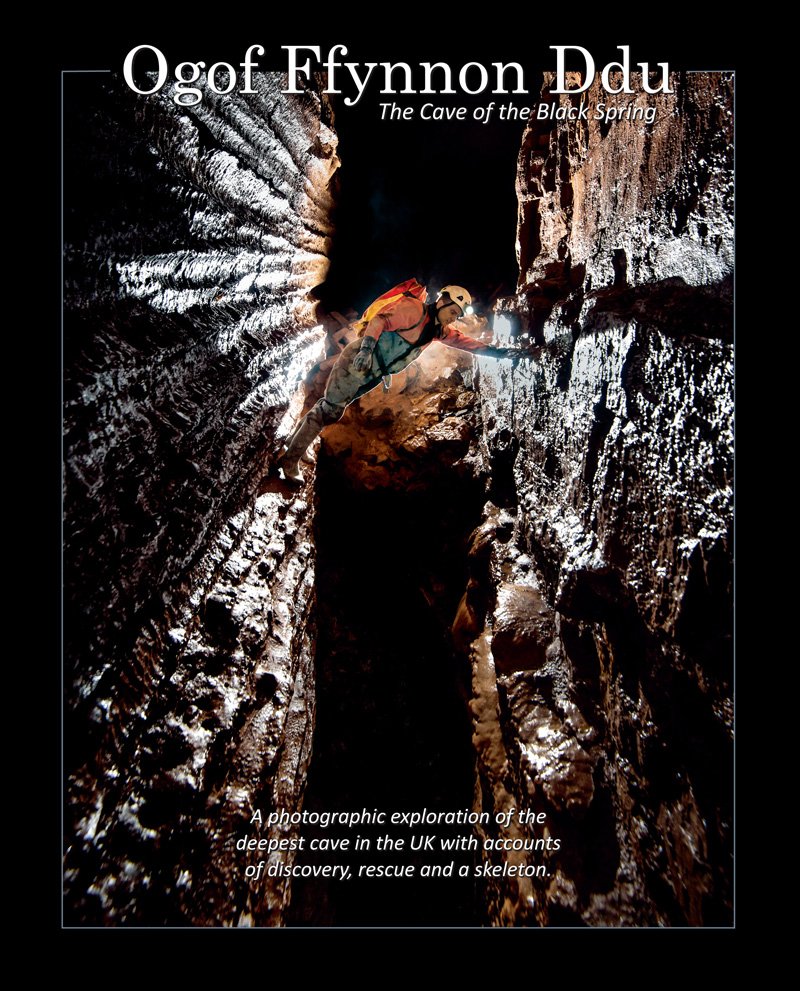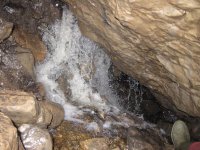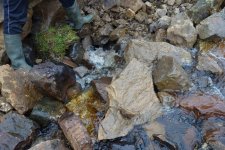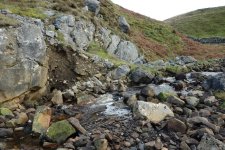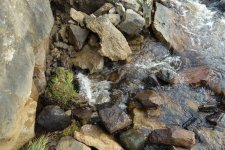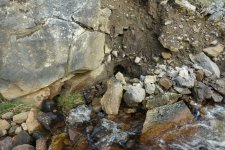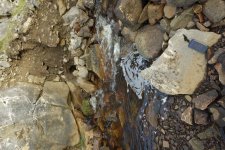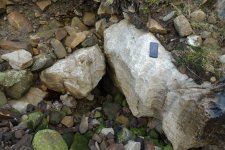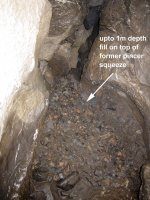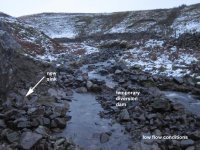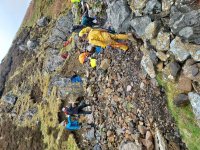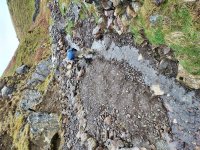!WARNING!
Erosion of the stream bank just downstream of the entrance to Aygill Caverns (near Bull Pot Farm) has drastically altered the local hydrology of Aygill, with serious consequences for access to the cave.
The gill has been steadily eating away at the bank for several years now, but without significant impact on access to the cave. This has all changed in the past two months.
On the 7th October during a resurvey trip the normal dry route to the Traverse Pitch was taken. At the bottom of the pitch a significant stream was found flowing from the upstream passage, which for many years has only contributed a trickle or small stream at best. The large stream was now flowing into the short low tube which leads to the second pitch and the main cave. The tube wasn't attempted, but would likely have been 'sporting' at the very least, and the pitch would have been a full-on cataract.
On the 18th November another trip was made to check on the water below the Traverse Pitch, as it was noticed that more of the surface stream appeared to be sinking than a month earlier. On this occasion the caver was stopped a mere 10 metres into the cave where a low crawl and short rift descend to a squeeze or wriggle through to an enlargement. This normally dry route was completely engulfed by a large stream issuing from the roof and falling down the rift to the squeeze. This would have been silly to attempt, and the squeeze would likely have offered a drowning experience.
On the 19th November, after 24+ hrs without rain, I returned to take another look at the situation. The surface stream had subsided to a moderate-to-normal flow. Once again, 10m into the cave a large inlet was met and, although slightly less boisterous than the previous day, it effectively stopped any further investigation. New cavities in the roof and wall suggest that the stream has loosened a lot of boulders which will have been washed down and most likely choked up against the squeeze at the bottom of the rift.
Effectively this situation closes the cave, either until a period of much drier weather, or until an efficient dam is built around the new sink.
* IT IS ADVISED NOT TO VISIT AYGILL CAVERNS UNTIL FURTHER NOTICE
(pic. shows inlet above rift/squeeze on 19/11/20 after 24+hrs without rain)
Erosion of the stream bank just downstream of the entrance to Aygill Caverns (near Bull Pot Farm) has drastically altered the local hydrology of Aygill, with serious consequences for access to the cave.
The gill has been steadily eating away at the bank for several years now, but without significant impact on access to the cave. This has all changed in the past two months.
On the 7th October during a resurvey trip the normal dry route to the Traverse Pitch was taken. At the bottom of the pitch a significant stream was found flowing from the upstream passage, which for many years has only contributed a trickle or small stream at best. The large stream was now flowing into the short low tube which leads to the second pitch and the main cave. The tube wasn't attempted, but would likely have been 'sporting' at the very least, and the pitch would have been a full-on cataract.
On the 18th November another trip was made to check on the water below the Traverse Pitch, as it was noticed that more of the surface stream appeared to be sinking than a month earlier. On this occasion the caver was stopped a mere 10 metres into the cave where a low crawl and short rift descend to a squeeze or wriggle through to an enlargement. This normally dry route was completely engulfed by a large stream issuing from the roof and falling down the rift to the squeeze. This would have been silly to attempt, and the squeeze would likely have offered a drowning experience.
On the 19th November, after 24+ hrs without rain, I returned to take another look at the situation. The surface stream had subsided to a moderate-to-normal flow. Once again, 10m into the cave a large inlet was met and, although slightly less boisterous than the previous day, it effectively stopped any further investigation. New cavities in the roof and wall suggest that the stream has loosened a lot of boulders which will have been washed down and most likely choked up against the squeeze at the bottom of the rift.
Effectively this situation closes the cave, either until a period of much drier weather, or until an efficient dam is built around the new sink.
* IT IS ADVISED NOT TO VISIT AYGILL CAVERNS UNTIL FURTHER NOTICE
(pic. shows inlet above rift/squeeze on 19/11/20 after 24+hrs without rain)

